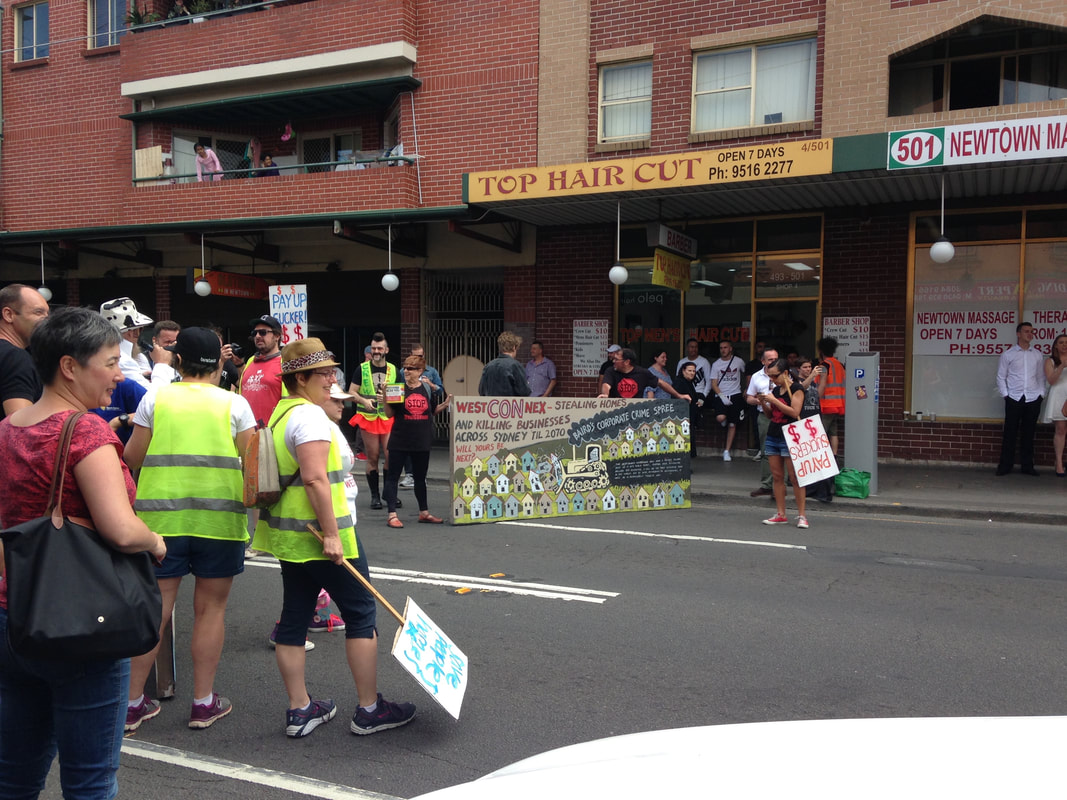|
This is part of a unit of work for Changing Places - Australia's Urban Future. Lesson 1: Australia's Projected Population Growth Lesson 2: Implications for Future Growth and Sustainability Lesson 3: Sydenham to Bankstown Urban Renewal Precinct Lesson 4: WestConnex - Sydney, Sustainability and Transport Lesson 4: Sydney Sustainability and Transport (Teacher's Notes) Lesson 5: The GreenWay Lesson 5: Deindustrialisation Lesson 6: Create an infographic Lesson 7: Contributing to a Sustainable Urban Future Lesson 7: WestConnex - Protest Movements and Impacts Lesson 7: Conflict Over Dulwich Hill OR See the complete unit on the Changing Places website. Social Movements Social movements can provide residents of a community with a means of influencing their local environment. They provide a way for residents to communicate opinions on planning and other matters to the formal planning structures and organisations, and to intervene in the formal political system. Activities of social movements can include letter-writing campaigns, protest meetings, and media campaigns. Social movements can be important agents of urban change and can empower local communities. An example of a social movement is the urban cycling movement which aims to reduce car dependence and improve sustainability of transport, increase safety on roads for cyclists and encourage a collective increase in personal health and wellbeing through exercise. Resident Action Groups Resident Action Groups are a form of social movement at a smaller scale, and usually involve issues of a short term nature. RAGs often tend to be localized and single-focused. Although these groups are usually designed to force significant changes in society as a whole, they can at times bring about change at a smaller scale. Unlike social movements more generally, RAGs are more obviously limited and can be interpreted as having NIMBY (not in my backyard) motives. Recent transport infrastructure development and proposals for high density throughout the Inner West of Sydney have created an increase in the number of RAGs and concentrated the patterns of RAGs around development sites. There are currently a large number of Resident Action Groups in the Inner West of Sydney protesting and lobbying against WestConnex and increased development. Examples include Rozelle Against WestConnex, Save Dully, and Newtown WestConnex Action Group. Rozelle Against WestConnex The Rozelle Against WestConnex group lobbies against WestConnex in general, but more specifically the Rozelle Interchange in the vicinity of the Rozelle Goods Yard, as well as the tunnels running below Denison and Darling Streets. This will involve acquisition and demolition of homes and businesses and creation of 12-metre high, unfiltered smoke stacks. Save Dully The Save Dulwich Hill Community Group promotes issues related to the redevelopment of the suburbs and lobbies the government to preserve the heritage of suburb. Visit the Save Dully website to read more about their actions. Dulwich Hill experienced growth in the late 1800s following the introduction of the tram line, and as a result contains buildings with heritage architecture, particularly Federation architecture. The Sydenham to Bankstown Urban Renewal Strategy, encompasses the suburb of Dulwich Hill, rezoning for higher density and redevelopment of older buildings. Save Dully is lobbying to ensure that the historic and diverse nature of Dulwich Hill is preserved. Newtown WestConnex Action Group The M4-M5 link tunnels will run underneath Newtown. Many Newtown business owners have begun protesting the development, worried that congestion and bottlenecks will negatively impact retail businesses, or alternatively that clearways along King St will kill business. The Newtown WestConnex Action Group has been formed. In Alexandria a new bridge is being constructed over the canal to allow movement of traffic from the St Peters interchange. Lesson Idea: Individual and community action Examine the ways that individuals and communities have contributed to the political process and discussions about the WestConnex project. Write a paragraph about 5 actions taken by individuals and communities. Do you think these have been effective? Do you think these actions are justified? What other actions could individuals or communities take? Examine a video of a council meeting about West Connex (try a simple search on Youtube). Consider how the different groups and individuals perceive how WestConnex impacts their community and/or environment. Choose a persona from one of the following: local resident, local councilor, construction worker, urban planner. Write a series of tweets that you might compose to tell your feelings and opinions about the issue. Take photographs of a site that will be or has been affected by WestConnex. You may use Google Street View if you are not close by to a relevant site. Annotate the photographs showing how features of the environment have changed or will change as a result of the WestConnex development. Assess how the changes to the site will impact on its environmental quality. Obtain aerial photographs of the Inner West of Sydney (these may be screen shots from Google Maps). Visually represent the changes that are taking place in the area. Annotate the aerial photographs showing locations affected by Planned Precincts, WestConnex and the Metroline. Include detail about the types of changes that are going to take place. Fieldwork: Questionnaire
Conduct a questionnaire on residents that live in the Inner West of Sydney. Design 8-10 questions to ask. Some examples:
0 Comments
Your comment will be posted after it is approved.
Leave a Reply. |
Categories
All
Archives
May 2024
|

